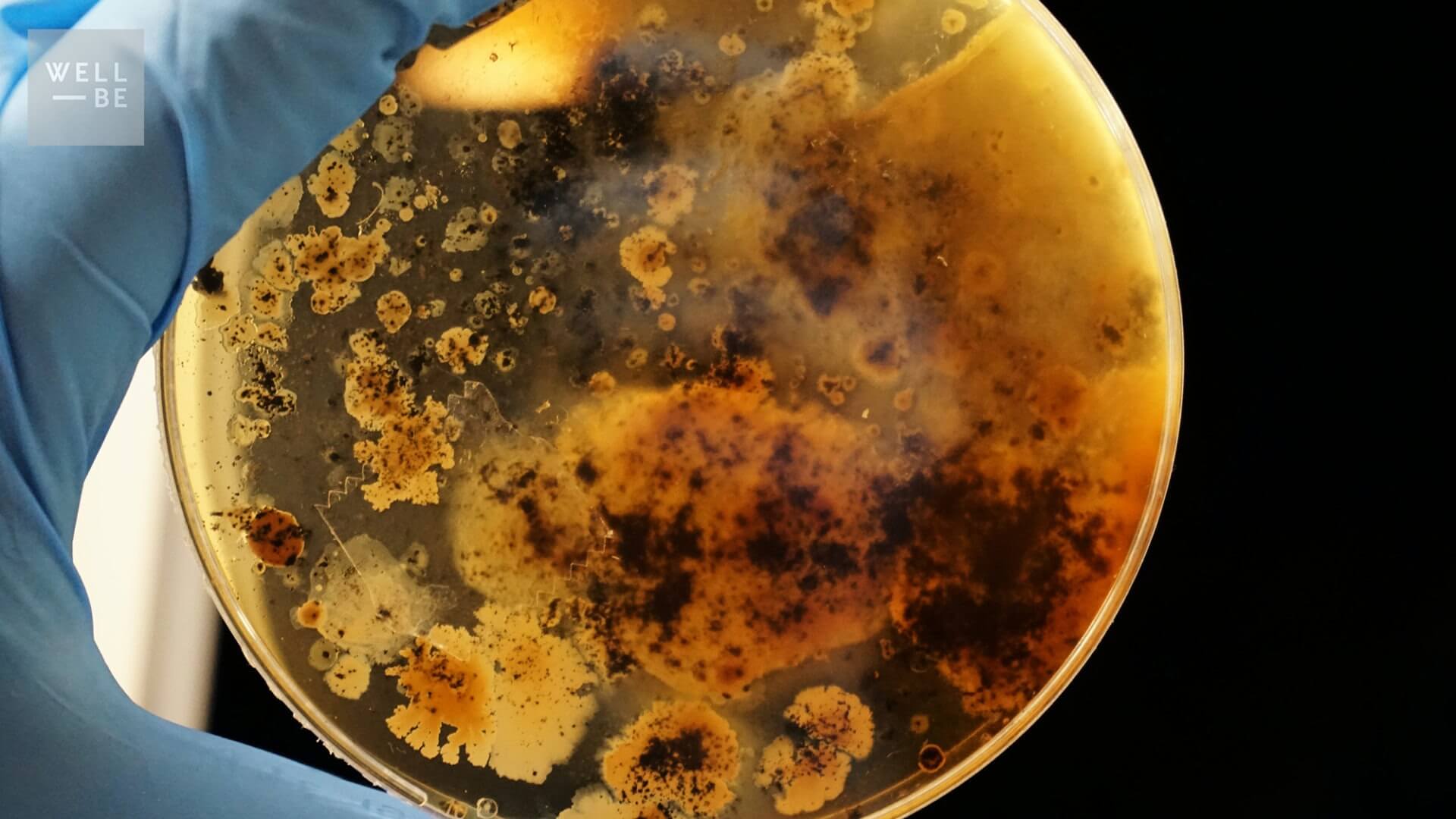We talk a lot about gut health over here at WellBe, since it impacts every single aspect of your well-being, both mental and physical. But often when we speak about gut health, we focus on the bacteria in your gut and not the other microbes, despite the fact that these other microbes also play a vital role in your health. One of the most important microbes is Candida, a form of yeast that supports various bodily functions in small amounts — but when there’s too much yeast in the body, things go haywire. Read on to learn about the signs of Candida overgrowth, the best Candida overgrowth treatment, the Candida overgrowth diet, and more.
You can also listen to Adrienne read this guide on The WellBe Podcast.
Defining Candida Overgrowth: What Happens When There’s Too Much Yeast in the Body?
Countless different kinds of microorganisms, known as microbes, live in your body. Taken together, this collection of different living beings is referred to as your microbiome, and its makeup has a significant impact on every aspect of your health. When we talk about the microbiome, especially the gut microbiome, most of us usually think of bacteria, but the microbiome also includes viruses, archaea (single-celled organisms that support various bodily functions), and fungi. One of the many types of fungi that live in the body is Candida, a form of yeast that’s found in small amounts in the intestines, mouth, vagina, and skin.
When your body has normal levels of Candida, the yeast causes no problems — in fact, it’s downright helpful! In small amounts, Candida facilitates digestion and nutrient absorption, while also supporting your immune system and helping maintain a good balance of different microbes. But when Candida levels start to rise, and suddenly there’s too much yeast in the body, problems crop up.
There are various different terms to describe this condition, including Candida overgrowth, Candida infection, candidiasis, Candida syndrome, and Candida albicans. While some of these terms have slightly different nuances, they all refer to the same general phenomenon of having excess Candida in your system.
A multitude of different factors could lead to too much yeast in the body. Because Candida resides primarily in your gut, basically anything that negatively affects your gut health could also be the trigger for a Candida overgrowth. So things like taking antibiotics, drinking too much alcohol, eating a high-sugar diet, excessive stress, or lack of sleep could all help set the stage for Candida issues (for in-depth instructions on achieving optimal gut health, download our free gut health guide).
Besides gut health, there are several other factors that can lead to Candida overgrowth:
- A weakened immune system: Candida has been classified as an “opportunistic” organism because it normally only causes diseases in living beings whose immune systems have been compromised (the immune defenses being down = an opportunity to attack, hence the name). So if you’re recovering from an illness, on immunosuppressant drugs, dealing with chronic inflammation, or otherwise have a weakened immune system, you’re at a higher risk for Candida overgrowth.
- Diabetes
- Iron deficiency anemia
- Hormonal issues: High levels of estrogen have been associated with Candida overgrowth, as the estrogen acts like a fertilizer for the yeast. So anything that throws off a woman’s natural balance of estrogen and progesterone could lead to an increase in Candida, including taking hormonal birth control, becoming pregnant, and other conditions associated with hormonal imbalance.
- Smoking
- Yeast-friendly environments. Yeast thrive in warm, moist areas, so hot and humid weather can be a trigger, as can wearing tight-fitting clothing that doesn’t let your skin breathe.
Signs of Candida Overgrowth
Wouldn’t it be nice if every condition mapped perfectly to a specific set of symptoms, and every symptom mapped perfectly back to one — and only one — underlying condition? Yeah, that would sure make things easier. Unfortunately, most health issues people deal with today come with a loose set of symptoms that, taken on their own, could be caused by a bunch of different things. The signs of Candida overgrowth are no different.
However, by understanding the range of symptoms associated with too much yeast in the body, and considering your own lifestyle and symptoms, you can get a sense of whether a Candida overgrowth might be to blame. While the symptoms are quite diverse, and you may only experience one or two at a time, these are the most common signs of Candida overgrowth:
- Digestive/gut issues: Maintaining a healthy balance of microbes in your body is essential for proper digestion and nutrient absorption. So if your Candida levels get too high, it will throw off the delicate balance of your microbiome and can lead to a wide range of issues associated with poor gut health. This could mean anything from diarrhea and constipation to nutritional deficiencies to more serious conditions like ulcerative colitis and Crohn’s disease.
- Fatigue: Candida doesn’t have any direct relationship to energy levels, but it does have other effects that, in turn, could contribute to fatigue. First, some of the nutritional deficiencies caused by Candida, like inadequate levels of magnesium and vitamin B6, are associated with fatigue. Also, too much Candida further weakens your immune system, which can cause you to feel tired.
- Oral thrush: If a Candida overgrowth occurs in the mouth (where small amounts of Candida are naturally found), it can cause an uncomfortable condition in the mouth and throat called “thrush.” Thrush presents as white, bumpy patches on the inside of the mouth and throat, which can be painful and bleed when scraped. In particularly bad cases, thrush can make it difficult to swallow. This symptom is most common in the elderly or those with poor oral hygiene.
- Thrush for breastfeeding moms and newborns: For new moms who find breastfeeding painful or have nipples that feel itchy or burning, look shiny, or have white patches, Candida overgrowth is a likely culprit. Same goes for a newborn with white, milky-looking patches in their mouth that bleed easily when touched, irritated red skin in the mouth, or a diaper rash that won’t go away. Remember that a newborn’s microbiome is very similar to the mother’s microbiome until they begin to eat solid food, so if one is experiencing a Candida overgrowth, it’s likely the other is as well.
- Yeast infections: Since Candida is a yeast, it’s probably not surprising that too much of it could cause yeast infections! Candida is normally found in small amounts on the vaginal tracts of most women, and when it begins to proliferate to higher levels, a yeast infection is often the result.
- Chronic sinus infections: Acute, short-term sinus infections are generally caused by bacteria, but fungus is often at the root of longer-term sinus infections. One study found that 96% of people with chronic sinus infections had fungi (yeast) in their mucus.
- Skin problems: An overgrowth of Candida on the skin can result in skin problems like itching, rashes, eczema, acne, or inflamed, cracked skin. A Candida overgrowth on the skin could be caused by anything that alters the skin’s microbiome, including temperature, humidity, cosmetics, and personal care products (especially anything antibacterial!). To ensure you’re only getting the cleanest, safest cosmetics and personal care products, use the WellBe Non-toxic Product Database.
- Nail issues: If you have a Candida overgrowth near your nail beds, the fungal infection can spread to the nails themselves, causing pain, redness, swelling, and discoloration of the nail.
- Joint pain: Sometimes, a Candida overgrowth gets so out of control that it enters your bloodstream and travels through your body, leading to issues in your joints. The term Candida arthritis refers to a condition where Candida in your blood leads to pain, stiffness, and swelling in your joints.
- Mood and mental health issues: Research has suggested that Candida overgrowth is more common in people with mental health conditions, though it’s unclear what the relationship is there besides that we know the gut and brain are intimately connected . Candida overgrowth also impairs absorption of micronutrients that are essential for recovery from psychiatric issues like anxiety, ADHD, and mood disorders, so having too much yeast in the body could make it more difficult to recover from or treat those conditions.
If left untreated, Candida overgrowth can lead to other complications. As the Candida continues to proliferate, it will do more and more damage to your gut lining and further throw off the balance of your microbiome. With your gut health so compromised, you’re at a much higher risk for developing increased intestinal permeability, aka leaky gut syndrome. Your immune system will also suffer (remember, 80% of your immune system is in your gut!), leading to more frequent colds, viruses, or other infections.
The Most Effective Candida Overgrowth Treatment
If you’re diagnosed with an overgrowth of Candida, most conventional doctors will prescribe an OTC or prescription antifungal medication as a Candida overgrowth treatment. These types of medication either kill the fungus or prevent it from growing, and can be quick, effective short-term solutions.
However, this approach targets symptoms rather than the root cause of the overgrowth, which means that there’s a good chance the problem could recur. Plus, medications always come with their own side effects and don’t address the environment in your body that allowed for Candida overgrowth in the first place. That’s why, if there’s a way to reverse a condition without pharmaceuticals, we’re all for it. Often, lifestyle choices can offer a side effect-free way to get to the root cause of an issue and stop the problem for good. And the good news is that Candida overgrowth treatment is no different!
To get your Candida levels down and restore a healthy balance in your gut, try these strategies:
- Practice good hygiene: Simple daily hygiene practices ensure that your skin and mouth don’t become a hospitable breeding ground for Candida. That means keeping your skin clean and dry, wearing breathable clothing, and practicing good dental hygiene.
- Stop any medications (if possible): Various pharmaceuticals, from antibiotics to steroids to birth control pills, could be contributing to a Candida overgrowth. If it’s possible, stop taking these medications completely, or talk with your doctor about getting on the lowest possible dose.
- Take probiotics: Probiotics are a great way to promote good microbes in your body, and can be especially helpful for restoring a balanced microbiome after a round of antibiotics. The probiotics Lactobacillus and S. boulardii have both been shown to be effective in Candida overgrowth treatment and prevention.
- Try aloe vera: Some research has shown that aloe vera gel may inhibit the growth of Candida, as pure aloe vera has antifungal properties. You can use pure aloe vera gel on your body if the Candida overgrowth is on your skin, or drink aloe vera juice to treat an internal Candida overgrowth.
- Herbal supplements: Certain herbs have anti-yeast and antifungal properties that can help lower Candida levels and restore balance in your gut. Herbal supplements like oregano oil, garlic extract, peppermint oil, and thyme extract may inhibit Candida growth.
Then, of course, there’s diet. This one’s a biggie, so let’s look at it more in-depth.
The Best Candida Overgrowth Diet
Because Candida lives in the gut, and your gut health is a direct result of what you eat and drink (among other factors), it follows that your diet can play a big role in causing and reversing Candida overgrowth. So if you think you have too much yeast in the body, what should you eat — and not eat — to get things back in order?
Thankfully, there’s some good research on the best Candida overgrowth diet, and many of the recommendations are good rules of thumb for healthy eating in general. Win-win!
First, let’s talk about the foods to avoid. Because Candida overgrowth is so intertwined with gut health, any foods that are bad for your gut could also trigger Candida issues. So that means avoiding processed foods, red meat, excessive alcohol, and artificial sweeteners. There are also specific foods that can feed Candida and encourage it to grow, including simple sugar (aka glucose, the sugar found in many processed foods), simple carbs (like white bread, crackers, chips), and high-lactose dairy products (milk, cream cheese, sour cream).
In terms of what you should eat, an effective Candida overgrowth diet will include a healthy balance of whole foods that support your gut health, as well as these specific foods that have been shown to inhibit the growth of Candida:
- Fruits: While the simple sugar glucose has been shown to cause Candida to proliferate, fructose, the slow-digesting sugar found in fruits, actually limits Candida growth. However, it’s important to take note of the sugar content in the fruit and avoid overly sweet forms. For instance, low-sugar, high-water-content fruits like strawberries, grapefruit, or watermelon are a good choice, while super sweet choices like pineapple, mango, dried fruits, and fruit juices could feed Candida.
- Pomegranate: While all fruits contain fructose, pomegranate specifically has other plant compounds that are beneficial in fighting off Candida yeast.
- Garlic: Garlic contains allicin, an antifungal substance that has been shown to inhibit Candida yeast in studies.
- Turmeric: Studies suggest that curcumin, the active substance in turmeric, may kill Candida yeast, or at least reduce their growth.
- Coconut oil: Lauric acid, which is found in high amounts in coconut oil, has been shown to fight Candida infections in several studies.
- Kombucha: Kombucha is high in polyphenols (an antioxidant-filled micronutrient found in plants) and acetic acid, both of which have been shown to kill Candida. Just be aware of the sugar level in the kombucha, as yeast like Candida feeds on sugar!
The WellBe Takeaway on Candida Overgrowth
Candida overgrowth can be a tricky condition to identify. However, it’s impact can be far-ranging, and, once diagnosed, there are very effective treatments to reverse the condition and prevent it from recurring. Here’s what to remember:
- The human microbiome is made up of various different microorganisms, including bacteria, viruses, archaea, and fungi. One of the many types of fungi in the body is Candida, a type of yeast.
- In healthy people, Candida exists in small amounts in the intestines, mouth, skin, and vagina. It aids with things like digestion and nutrient absorption, and supports the immune system.
- Various factors can cause Candida levels to rise above normal, leading to a whole host of different symptoms. Common signs of Candida overgrowth include oral thrush, fatigue, digestive issues, mood or mental health issues, skin problems, nail problems, joint pain, yeast infections, and chronic sinus infections.
- A Candida overgrowth can be caused by anything that compromises your gut health or your immune system. Other risk factors include diabetes, obesity, taking antibiotics, iron deficiency anemia, hormonal imbalances, and smoking.
- Doctors often prescribe antifungal medication as Candida overgrowth treatment. However, there are other, natural treatment approaches, including stopping any medications that might be contributing to it (birth control, steroids, antibiotics), using aloe vera, taking probiotics and/or herbal supplements, and practicing good hygiene (but not using anything antibacterial or overwashing!).
- In terms of diet, the best Candida overgrowth diet cuts out foods that harm gut health and promote the growth of Candida, including refined sugars, processed foods, simple carbohydrates, and dairy. Foods that help fight Candida include low-sugar fruits (especially pomegranate), garlic, kombucha, turmeric, and coconut oil.
Have you ever experienced Candida overgrowth? How did you treat it? Share your experience in the comments below!
You can also listen to an audio version of this guide on The WellBe Podcast.
Citations:
- Raz-Pasteur, A et al. “The pathogenesis of Candida infections in a human skin model: scanning electron microscope observations.” ISRN dermatology vol. 2011 (2011): 150642.
- Jenkinson HF, Douglas LJ. Interactions between Candida Species and Bacteria in Mixed Infections. In: Brogden KA, Guthmiller JM, editors. Polymicrobial Diseases. Washington (DC): ASM Press; 2002. Chapter 18.
- Fourie, Ruan et al. “Iron at the Centre of Candida albicans Interactions.” Frontiers in cellular and infection microbiology vol. 8 185. 5 Jun. 2018.
- Soysa NS, Ellepola AN. The impact of cigarette/tobacco smoking on oral candidosis: an overview. Oral Dis. 2005 Sep;11(5):268-73.
- Lalla RV, Patton LL, Dongari-Bagtzoglou A. Oral candidiasis: pathogenesis, clinical presentation, diagnosis and treatment strategies. J Calif Dent Assoc. 2013 Apr;41(4):263-8. PMID: 23705242.









I really enjoyed this post! I’m currently dealing with candida overgrowth and I’m finding that some of the natural remedies you mentioned are really helping me feel better. Thanks for sharing!
This post is incredibly helpful! I had no idea there were so many natural treatment options for Candida overgrowth. I’m definitely going to try incorporating more probiotics into my diet and exploring the herbal remedies you mentioned. Thanks for sharing your insights!
We are so glad you found this helpful in your healing journey! Best of luck! Xo, WellBe
Thank you for sharing these natural treatment options for Candida overgrowth! I’ve been struggling with this issue for a while, and your insights on diet and herbal remedies have given me some great ideas to try. I appreciate the detailed approach and look forward to seeing how these changes will impact my health.
So glad to hear this! Xo, Team WellBe
Thanks for sharing these natural treatment options for candida overgrowth! I’ve been struggling with this issue for a while, and it’s great to see some practical tips. I can’t wait to try some of these remedies and see if they help.
So happy to hear that you found this article helpful. Good luck with treatment 🙂 Xo, Team WellBe